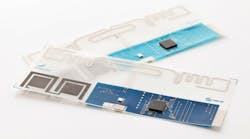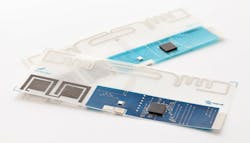European studies into global food wastage indicate that 40% to 50% of all food being produced for Europe is being wasted. Surprisingly, 10% to 15% of that wastage is happening during supply and delivery operations to consumer retail outlets. In addition, the food industry discards an estimated $25 billion of spoiled goods every year. Within every home, $300 worth of bruised fruit, bad meat, and other perishable goods are thrown away annually. This issue has serious implications for the global supply of adequate food stocks. It also contributes to escalating food costs. In a technological step forward that could combat this wastage, Europe’s CATRENE-Pasteur project has developed a flexible tag that can track and monitor the quality of food in the supply chain.
This monitoring system integrates an RF-identification (RFID) chip, microcontroller, and sensor integrated circuit (IC) into a flexible tag (see photo). The sensor IC, which will be made commercially available later this year, incorporates temperature, relative humidity, and light sensors. As a result, it can monitor the quality of a range of foods.
Here is a technology demonstrator of the CATRENE-Pasteur project, which integrates an RFID chip, microcontroller, and sensor IC into a flexible tag.
To perform such monitoring, the tag attaches to bulk transportation containers. It then provides continuously updated data on how long the food stored in those containers will stay fresh. This could help food distributors minimize the amount of food that is spoiled before it reaches the retailer.
Researchers from Holst Centre and Imec played a role in integrating the ICs into the flexible tag. This involved the creation of low-temperature encapsulation techniques that would not damage the low-cost plastic substrate used in the tag. To integrate the sensor IC, the team developed a process that protects most of the chip, but leaves the sensing area exposed to make measurements. This process attaches the IC to the encapsulation material using an adhesive conductive film. Using lasers, that film is then machined to the required size and shape. This technique ensures that the sensing area remains uncontaminated.
Holst Centre and Imec also participated in the development of additional gas sensors. Eventually, those sensors may be used to monitor the controlled atmosphere in which many foods are packaged. By creating ultrathin metal-oxide films, they were able to enhance the sensitivity of oxygen and carbon-dioxide sensors. The sensor can operate at room temperature, which reduces power requirements. For the carbon-dioxide sensor, the team achieved sensitivity in the 300-to-5000-ppm concentration range used in food-packaging applications.
Further models for food-quality prediction are being developed based on available sensor data. They will be translated into algorithms that can be implemented on the smart sensor tag. In addition, technologies are being developed to reduce power requirements and boost read efficiency.
The first-generation (Gen1) demonstrator of the RFID-sensor tag provides a test prototype to validate system feasibility. Although it is a modular test platform, the final, fully integrated version will be a battery-assisted RFID tag with full sensor functionality. In addition to making accurate shelf-life predictions for specific food items, it will be able to sense a number of different parameters, such as temperature, pH, and gas levels.
According to the CATRENE-Pasteur project, a vast variety of applications will result from the successful development of a marketable platform. They include supply-chain uses, such as traceability and quality management. In addition, domestic applications include the detection of hazardous gases like carbon monoxide. Medical monitoring could be performed to ensure therapy compliance. Applications even range to construction—for example, for corrosion monitoring. The CATRENE-Pasteur project was funded by the governments of Austria, Belgium, the Netherlands, and Spain. Participants include major European companies, research institutes, and universities.

